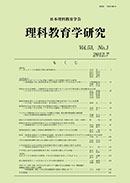Volume 48, Issue 1
Displaying 1-13 of 13 articles from this issue
- |<
- <
- 1
- >
- >|
Original Papers
-
2007Volume 48Issue 1 Pages 1-11
Published: July 31, 2007
Released on J-STAGE: June 30, 2022
Download PDF (1446K) -
2007Volume 48Issue 1 Pages 13-19
Published: July 31, 2007
Released on J-STAGE: June 30, 2022
Download PDF (1369K) -
2007Volume 48Issue 1 Pages 21-33
Published: July 31, 2007
Released on J-STAGE: June 30, 2022
Download PDF (1338K) -
2007Volume 48Issue 1 Pages 35-49
Published: July 31, 2007
Released on J-STAGE: June 30, 2022
Download PDF (2110K) -
2007Volume 48Issue 1 Pages 51-61
Published: July 31, 2007
Released on J-STAGE: June 30, 2022
Download PDF (1579K) -
2007Volume 48Issue 1 Pages 63-73
Published: July 31, 2007
Released on J-STAGE: June 30, 2022
Download PDF (1370K) -
2007Volume 48Issue 1 Pages 75-84
Published: July 31, 2007
Released on J-STAGE: June 30, 2022
Download PDF (1810K) -
2007Volume 48Issue 1 Pages 85-93
Published: July 31, 2007
Released on J-STAGE: June 30, 2022
Download PDF (1187K) -
2007Volume 48Issue 1 Pages 95-101
Published: July 31, 2007
Released on J-STAGE: June 30, 2022
Download PDF (925K) -
2007Volume 48Issue 1 Pages 103-116
Published: July 31, 2007
Released on J-STAGE: June 30, 2022
Download PDF (1688K) -
2007Volume 48Issue 1 Pages 117-124
Published: July 31, 2007
Released on J-STAGE: June 30, 2022
Download PDF (1146K) -
2007Volume 48Issue 1 Pages 125-132
Published: July 31, 2007
Released on J-STAGE: June 30, 2022
Download PDF (879K) -
2007Volume 48Issue 1 Pages 133-143
Published: July 31, 2007
Released on J-STAGE: June 30, 2022
Download PDF (1382K)
- |<
- <
- 1
- >
- >|
